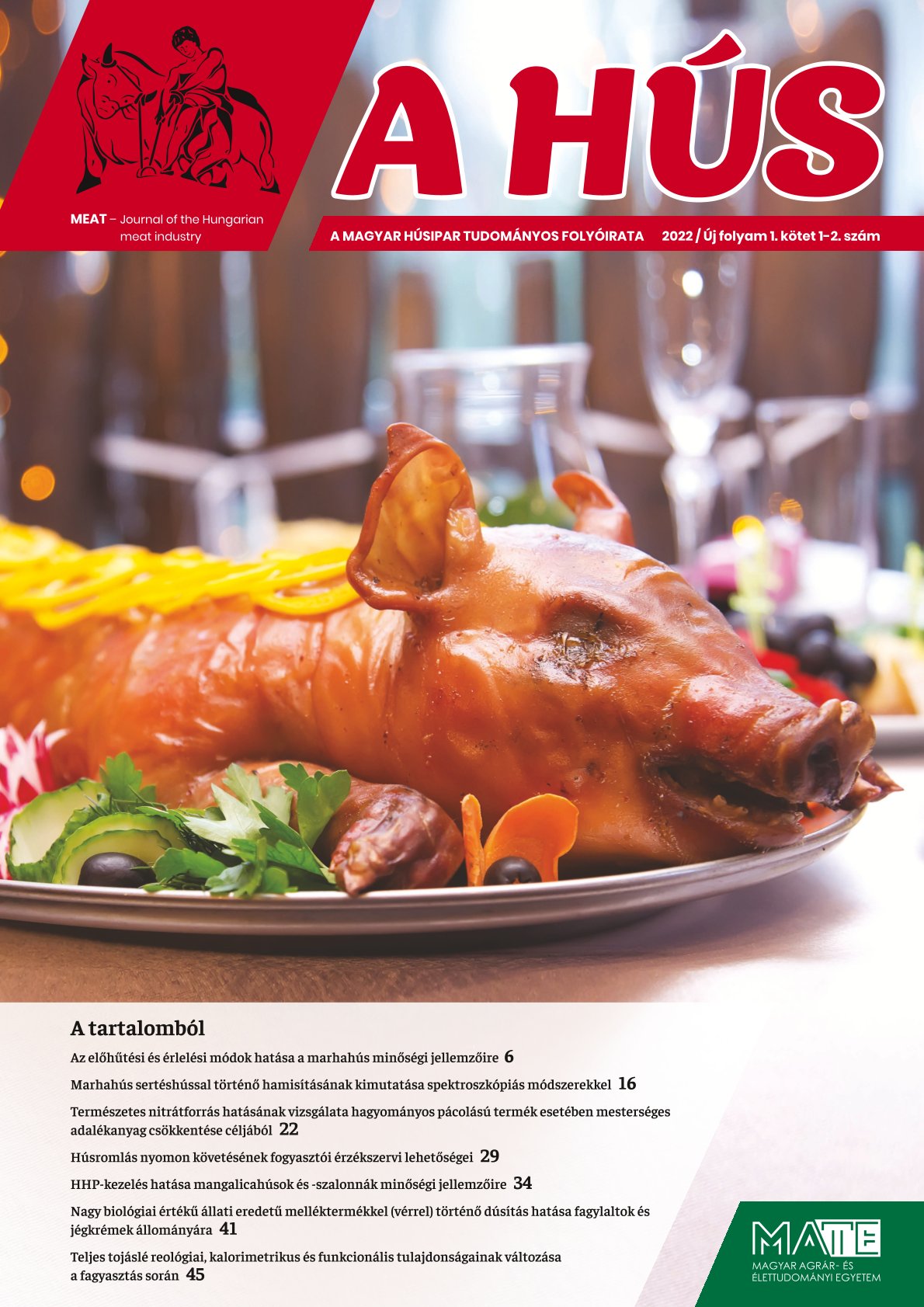Detection of adulteration of beef with pork using spectroscopic methods
Part 1.
DOI:
https://doi.org/10.56616/meat.3411Keywords:
detection of food fraud, detection of food adulteration, infrared spectroscopic methodsAbstract
In a balanced diet, meat consumption is of great nutritional importance. With the world population growing rapidly, meat consumption is also on the rise. With increasing consumer demand and a highly complex food supply chain, guaranteeing the quantity, quality and authenticity that consumers expect is a major challenge. Meat and meat products are also often suspected of food fraud and adulteration. The detection of food fraud and adulteration is very important for both economic and health reasons. In our research, published in two parts, we aimed at both reviewing the literature on food adulteration and modelling the detection of minced beef adulteration with pork using state-of-the-art near infrared spectroscopic methods. In this article, we have detailed the descriptive characteristics of the economic, nutritional importance, quality and authenticity of meat. In addition, the problem of food adulteration, its legal background and examples of state-of-the-art methods successfully applied in detection are presented. Materials, methods and key findings used in food adulteration experimental modelling are summarised in the next issue.
References
A 2008. évi XLVI. törvény az élelmiszerláncról és hatósági felügyeletéről. Letöltve: 2022. 07. 01. forrás: https://net.jogtar.hu/jogszabaly?docid=a0800046.tv
AZ EURÓPAI PARLAMENT ÉS A TANÁCS 853/2004/EK RENDELETE (2004. április 29.) az állati eredetű élelmiszerek különleges higiéniai szabályainak megállapításáról. Letöltve: 2022. 07. 03. forrás: https://eur-lex.europa.eu/LexUriServ/LexUriServ.do?uri=CONSLEG:2004R0853:20110311:HU:PDF
BÁZÁR, GY. (2011): Közeli infravörös spektroszkópia alkalmazási lehetőségei sertéshús és húskészítmények, valamint sertészsír minősítésében. Kaposvári Egyetem Állattudományi Kar, Mezőgazdasági Termékfeldolgozás és Minősítés Tanszék, Doktori Értekezés
BODOR, ZS., BENEDEK, CS., KASZAB, T., KOVACS, Z. (2018): Application of classical and correlative analytical methods on honey origin identification. (pp. 1–6.) In XIX. Risk Factors and Food Chain Conference, Hungary, Mátrafüred, 26-28, of September
BODOR, ZS., KOVACS, Z., RASHED, M. S., KÓKAI, Z., DALMADI, I., BENEDEK, C. (2020): Sensory and physicochemical evaluation of acacia and linden honey adulterated with sugar syrup. Sensors, 20 (17): 4845. https://doi.org/10.3390/s20174845
CASADEI, E. VALLI, E., PANNI, F., DONARSKI, J., GUBERN, J. F., LUCCI, P., CONTE, L., LACOSTE, F., MAQUET, A., BRERETON, P., BENDINI, A., TOSCHIA, T. G. (2021): Emerging trends in olive oil fraud and possible countermeasures. Food Control, 124 paper 107902 https://doi.org/10.1016/j.foodcont.2021.107902
CSAPÓ, J., ALBERT, CS., KISS, D. (2020): Analitikai kémia élelmiszermérnököknek. Scientia Kiadó, Kolozsvár, 2. átdolgozott bővített kiadás
HADDI, Z., BARBRI, N. E., TAHRI, K., BOUGRINI, M., BARI, N. E., LLOBET, E., BOUCHIKHI, B. (2015): Analytical methods instrumental assessment of red meat origins and their storage time using electronic sensing systems. Analytical Methods, 7 (12):5193-5203 https://doi.org/10.1039/c5ay00572h
JÁVOR, A., SZIGETI, J. (2011): Termékminősítés és termékhigiénia. Debreceni Egyetem, Nyugat-Magyarországi Egyetem, Pannon Egyetem
MILLER, R. K. (2002): Factors affecting the quality of raw meat. Meat Processing, 27-63. https://doi.org/10.1533/9781855736665.1.27
MUNCAN, J., TSENKOVA, R. (2019): Aquaphotomics - from innovative knowledge to integrative platfor in science and technology. Molecules, 24 (15): 2742 https://doi.org/10.3390/molecules24152742
PREVOLNIK, M., CANDEK-POTOKAR, M., SKORJANC, D. (2004): Ability of NIR spectroscopy to predict meat chemical composition and quality – a review. Czech Journal of Animal Science, 49 (11): 500-515 https://doi.org/10.17221/4337-CJAS
RANKEN, M. D. (2000): Handbook of meat product technology. Wiley-Blackwell; 1st edition
SPINK, J., MOYER, D. C. (2011): Defining the public health threat of food fraud. Journal of Food Science, 76 (9): R157- R163 https://doi.org/10.1111/j.1750-3841.2011.02417.x
TSENKOVA, R., MUNĆAN, J., POLLNER, B., KOVÁCS, Z. (2018): Essentials of aquaphotomics and its chemometrics approaches. Frontiers in Chemistry, 6: 363. https://doi.org/10.3389/fchem.2018.00363
VITÁLIS, F., ZAUKUU, J. L., BODOR ZS., AOUADI, B., HITKA, G., KASZAB, T., ZSOM-MUHA, V., GILLAY, Z., KOVÁCS, Z. (2020): Detection and quantification of tomato paste adulteration using conventional and rapid analytical methods. Sensors, 20: 6059. https://doi.org/10.3390/s20216059.
YU, P., LOW, M. Y., ZHOU, W. (2018): Design of experiments and regression modelling in food flavour and sensory analysis - A review. Trends in Food Science & Technology, 71: 202-215. https://doi.org/10.1016/j.tifs.2017.11.013
ZAUKUU, J. Z., BODOR, ZS., VITÁLIS, F., ZSOM-MUHA, V., KOVÁCS, Z. (2019b): Near infrared spectroscopy as a rapid method for detecting paprika powder adulteration with corn flour. Acta Periodica Technologica, (50): 346-352 https://doi.org/10.2298/apt1950346z
ZAUKUU, J. Z., SOÓS, J., BODOR, ZS., FELFÖLDI, J., MAGYAR, I., KOVÁCS, Z. (2019a): Authentication of Tokaj wine (Hungaricum) with the electronic tongue and near infrared spectroscopy. Journal of Food Science, 84 (12): 3437-3444. https://doi.org/10.1111/1750-3841.14956
ZAUKUU, J. Z.; GILLAY, Z., KOVÁCS, Z. (2021): Standardized extraction techniques for meat analysis with the electronic tongue: A case study of poultry and red meat adulteration. Sensor, 21 (2): Paper 481. https://doi.org/10.3390/s21020481
Downloads
Published
Issue
Section
License
Copyright (c) 2022 Józsa Kata, Vitális Flóra, Kovács Zoltán, Zsarnóczay Gabriella

This work is licensed under a Creative Commons Attribution-NonCommercial-NoDerivatives 4.0 International License.


